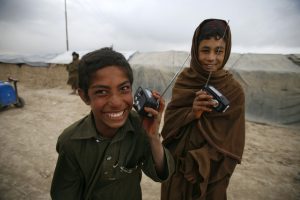TV Use Overtakes Radio in Afghanistan


WASHINGTON — Research data from the Broadcasting Board of Governors and Gallup shows that the media market in Afghanistan is primarily split between radio and television. While Afghanistan remains one of the few media markets in which shortwave radio use is still in the double digits, presenters at a research briefing today showed that TV use is overtaking radio for the first time in the country.
“Viewership rates are particularly high in the northern part of Afghanistan, where the electricity supply is more reliable, and drop off in the south where we see more Taliban activity,” said Paul Tibbitts, director of market insight and evaluation at Radio Free Europe/Radio Liberty.
TV usage has nearly doubled since 2008, with current weekly viewership at 64% of the total population. Urban residents and non-Pashtuns are more likely to tune in, and TV viewing also increases with education level.
“Those with a post-secondary education are the most avid media users for news overall,” said Sonja Gloeckle, director of research for the International Broadcasting Bureau. Highly educated Afghans were more likely to use TV (72%), radio (51%), Internet (19%), SMS (15%), and social media (14%) on a daily basis for news than other segments of the population.
These findings indicate the best media avenues to reach Afghans during a particularly uncertain transition with continued NATO troop withdrawals. According to Gallup World Poll data, Afghans’ quality of life ratings are at the lowest in eight years. Based on self-reporting zero Afghans can be considered “thriving” within Gallup’s life evaluation scale.
“When you see life evaluation assessments as dismal as what we see in Afghanistan coupled with the anticipated withdrawal of NATO forces and a murky political roadmap, it is quite concerning for all of us following events in the country closely,” said Mohamed Younis, senior analyst and senior practice consultant with Gallup.
A research brief and presentation with further information about this data can be found here, and a video of the briefing will be added in the coming days. More information about the BBG’s media research series is available here.
